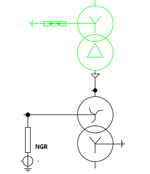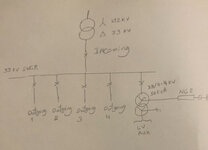Your first mistake is a delta secondary in a distribution network.
That configuration was common in the first part of the last century. By the 1950s many delta distribution systems had been converted to wye secondary systems
Eg: 19,000 delta to 33kV/19kV wye.
A common voltage and conversion was from 2400 Volts to 4160/2400 Volts.
The 220 Ohm resistor will limit the ground current to 19,000 Volts / 220 Ohms = 86 Amps
If you must connect 19,000 volt loads on the 33,000 Volt delta, the best solution is to install an artificial neutral locally to derive 19,000 Volts..
Consider this a source of 19,000 Volts AND NOT A NEUTRAL.
The connection to the artificial neutral may rise to line to ground voltage (19,000 Volts) in the event of a ground fault on the 33,000 Volt distribution system.
Grounding the artificial neutral will interfere with the operation of the NGR.
Both conductors of the 19,000 Volts derived with the artificial neutral must be considered "HOT" conductors and must be insulated for at least 19,000 Volts. (Good practice is to use 33,00 Volt rated conductors)
Disconnects must open both conductors,
Even though the derived 19,000 Volts will be near zero Volts to ground under normal conditions, you must consider that ground faults on a distribution system must be considered as WHEN a fault will happen, not IF a fault will happen.


